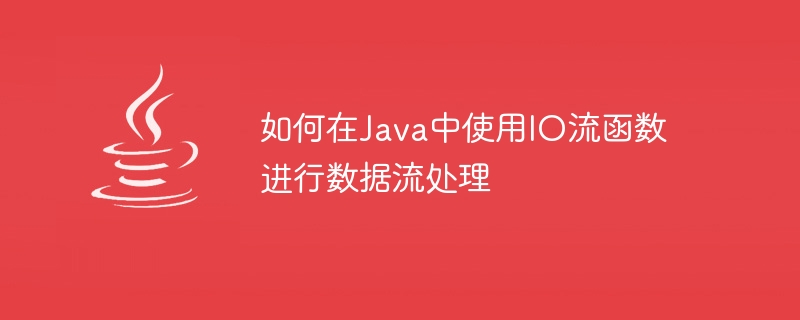Home >Java >javaTutorial >How to use IO stream functions for data streaming in Java
How to use IO stream functions for data streaming in Java
- WBOYWBOYWBOYWBOYWBOYWBOYWBOYWBOYWBOYWBOYWBOYWBOYWBOriginal
- 2023-10-26 12:37:55727browse

How to use IO stream function for data stream processing in Java
In Java programming, IO stream is a very important concept. It is used to process input and One of the basic ways of output. IO streams are used in scenarios such as reading files, network programming, and interacting with external devices. This article will introduce how to use IO stream functions for data stream processing in Java and give specific code examples.
- Understand the concept of IO stream
Before starting to use the IO stream function, we need to first understand the concept of IO stream. IO stream refers to the flow of data between input devices and output devices. It can be read and written byte by byte, or read and written block by block. Java provides various IO stream classes, such as byte stream, character stream, buffer stream, etc., for processing different types of input and output. - Use of IO stream function
2.1 Byte stream function
Java's byte stream class is divided into two types: input stream and output stream. When processing files, the commonly used input stream class is FileInputStream, and the output stream class is FileOutputStream. We can read and write files using the functions provided by these classes.
Reading file example:
import java.io.FileInputStream;
import java.io.IOException;
public class ByteStreamExample {
public static void main(String[] args) {
try {
FileInputStream fis = new FileInputStream("input.txt");
int data;
while ((data = fis.read()) != -1) {
System.out.print((char) data);
}
fis.close();
} catch (IOException e) {
e.printStackTrace();
}
}
}Writing file example:
import java.io.FileOutputStream;
import java.io.IOException;
public class ByteStreamExample {
public static void main(String[] args) {
try {
FileOutputStream fos = new FileOutputStream("output.txt");
String data = "Hello, World!";
byte[] bytes = data.getBytes();
fos.write(bytes);
fos.close();
} catch (IOException e) {
e.printStackTrace();
}
}
}2.2 Character stream function
Java's character stream class is also divided into input streams and output streams. When processing text files, the commonly used input stream class is FileReader, and the output stream class is FileWriter. Character stream functions handle character encoding issues in text files better than byte streams.
Reading file example:
import java.io.FileReader;
import java.io.IOException;
public class CharacterStreamExample {
public static void main(String[] args) {
try {
FileReader reader = new FileReader("input.txt");
int data;
while ((data = reader.read()) != -1) {
System.out.print((char) data);
}
reader.close();
} catch (IOException e) {
e.printStackTrace();
}
}
}Writing file example:
import java.io.FileWriter;
import java.io.IOException;
public class CharacterStreamExample {
public static void main(String[] args) {
try {
FileWriter writer = new FileWriter("output.txt");
String data = "你好,世界!";
writer.write(data);
writer.close();
} catch (IOException e) {
e.printStackTrace();
}
}
}2.3 Buffered stream function
In order to improve IO performance, Java provides the buffered stream class. The buffered stream inherits from the byte stream or character stream and overrides some of its methods to provide buffering functionality. Commonly used buffered stream classes include BufferedInputStream, BufferedOutputStream, BufferedReader and BufferedWriter.
Example of reading a file using a buffered stream:
import java.io.BufferedReader;
import java.io.FileReader;
import java.io.IOException;
public class BufferedStreamExample {
public static void main(String[] args) {
try {
BufferedReader reader = new BufferedReader(new FileReader("input.txt"));
String line;
while ((line = reader.readLine()) != null) {
System.out.println(line);
}
reader.close();
} catch (IOException e) {
e.printStackTrace();
}
}
}Example of writing a file using a buffered stream:
import java.io.BufferedWriter;
import java.io.FileWriter;
import java.io.IOException;
public class BufferedStreamExample {
public static void main(String[] args) {
try {
BufferedWriter writer = new BufferedWriter(new FileWriter("output.txt"));
String data = "Hello, World!";
writer.write(data);
writer.close();
} catch (IOException e) {
e.printStackTrace();
}
}
}- Summary
By using IO streams in Java Function, we can conveniently perform data stream processing, read and write files. This article introduces the use of byte stream functions, character stream functions and buffer stream functions, and gives specific code examples. I hope these examples can help readers better understand and apply IO stream functions.
The above is the detailed content of How to use IO stream functions for data streaming in Java. For more information, please follow other related articles on the PHP Chinese website!

